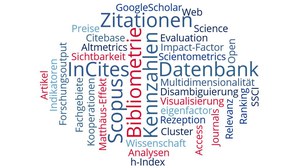Bibliometrics
Bibliometrics may help you to quantify, analyse, compare, and communicate the impact of your research output. Bibliometric analyses can provide information on the scientific publication performance, the integration into the scientific community and the internatioal recognition of research output. On this website you will find briefly summarised what you need to know about bibliometrics and citation-based research evaluation.
 © Wortwolken
© Wortwolken
Bibliometrics and Impact of Research
In simple terms, bibliometrics measures the impact of a person (Author Level Metrics, e.g. h-Index), of a publication (publication based indicators, e.g. citations) or a journal (journal-based indicators e.g. impact factor) onto research. Bibliometric analyses can be used as quantitative assessment and evaluation criteria. But they should always take into account subject-specific differences and not be used as the sole evaluation tool.
With the help of bibliometric analyses, extremely large amounts of data can be evaluated and put into context. For this reason, they are increasingly used in science management, in the evaluation of institutions and research networks, in the identification of research and technology trends and in the compilation of rankings. However, as with any complexity reducing method, it is always important to ensure that the question to be answered and the chosen indicator are in line.
If you have any questions concerning bibliometrics and contact, the Research Information Department will be happy to help you.
For individual services, the Bibliometrics Team of the Saxon State Library - State and University Library (SLUB) will be happy to assist you.





